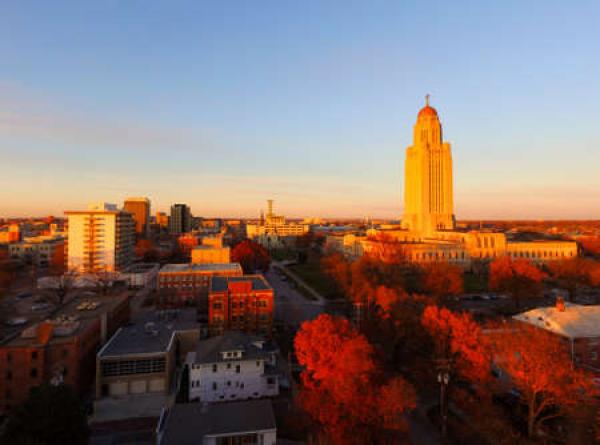 The second phase of The New SLC Redevelopment Program was officially completed in late 2023, bringing the completion of the Salt Lake City International Airport one step closer. The redevelopment program broke ground in 2014 as part of an effort to totally overhaul what had become an outdated facility ill-equipped to take on the 26 million passengers the airport sees each year. There’s still work to be done, but the parts that have been completed reflect a modern, spacious, safe airport with world-class amenities.
The second phase of The New SLC Redevelopment Program was officially completed in late 2023, bringing the completion of the Salt Lake City International Airport one step closer. The redevelopment program broke ground in 2014 as part of an effort to totally overhaul what had become an outdated facility ill-equipped to take on the 26 million passengers the airport sees each year. There’s still work to be done, but the parts that have been completed reflect a modern, spacious, safe airport with world-class amenities.
What Phase II of the Project Entailed
The official end of Phase II construction came on the morning of Oct. 31, 2023, when airport officials unveiled the gates restaurants of Concourse A-East before the inaugural flight departed the concourse to Atlanta. The new concourse features 13 Delta Airlines gates and 12 restaurants, including establishments local to Salt Lake City such as Red Rock Brewery, Vessel Kitchen, and Blue Iguana, as well as national chains like Jimmy John’s, Auntie Anne’s, and Burger King.
Other establishments present at the new concourse include Hugo Coffee Roasters, Hudson News and Hudson Nonstop, Millcreek Coffee Roasters, PF Chang’s, Wow Bao, Utah Jazz Store, SLC Public Market, The Atrium, Protein Bar & Kitchen, Minute Suites, and Rockwell Ice Cream.
Holder Construction, Big D Construction, Austin Commercial, and Okland Construction were responsible for various aspects of the construction work.
Art has been important to the redevelopment project and this new concourse is no exception. The restrooms feature wall murals, each painted by a different local artist. Meanwhile, there are multiple sculptures created by a local artist hanging in the concourse.
The opening of Phase II actually began in May 2023 when five new gates opened in Concourse A. Salt Lake City Mayor Erin Mendenhall said in a press release that this will enhance the airport’s status as a global Delta Hub.
“Salt Lake City is proud to be a Delta hub in the West and home to one of the top-performing airports in the world,” she said. “The completion of Phase 2 will provide efficient services and modern facilities for travelers who are eager for a seamless journey.”
An Ambitious, but Necessary Project
When the redevelopment project began in 2014, the airport was nearly half a century old. Salt Lake City’s population had grown substantially in that time, while the airport had become a western hub of activity. By the time the redevelopment project began, the facility was taking in about twice as many passengers (26 million annually) as it was designed to handle. The new airport can now handle up to 34 million passengers per year.
Phase I of the project, which took more than six years to complete, included the Central Terminal, Concourse A-west and Concourse B, a rental car service, parking garage, and quick turn around facilities. When Phase 1 was completed, the original airport was demolished, and the initial phase of the new airport opened. The first phase is more than 296.7 acres and totals more than four million square feet.
The redevelopment project continues. Phase III, currently underway, features eight additional gates and a tunnel that will connect Concourse B to the main terminal. The expected completion date is late 2024. Following that, construction on the fourth and final phase of the project will begin. This will involve expanding Concourse B and is expected to be finished in 2027.
At Construction Protection Systems, we’re proud to have played a small part in the Salt Lake City International Airport Redevelopment. Stay tuned for more updates from the makers of 1-2-3 Door Shield—the original, reusable door protection system.

 For the past three months, Nashville International Airport (BNA) has been a bit busier than in the past. Since October, flights have been flying into and departing from a new eight-gate satellite concourse, an extension on the airport’s main terminal. The new concourse, added to accommodate increased travel to Nashville and Middle Tennessee broadly, is one part of the larger $1.2 billion BNA Vision redevelopment project that began back in 2017.
For the past three months, Nashville International Airport (BNA) has been a bit busier than in the past. Since October, flights have been flying into and departing from a new eight-gate satellite concourse, an extension on the airport’s main terminal. The new concourse, added to accommodate increased travel to Nashville and Middle Tennessee broadly, is one part of the larger $1.2 billion BNA Vision redevelopment project that began back in 2017. After years of planning, tough decisions, and construction work, the first phase of Amazon’s second headquarters (HQ2) opened for business in Arlington, VA in June 2023. The massive development, which now serves as the workplace for thousands of employees, was first announced more than six years ago. Quite a bit has happened in the intervening time.
After years of planning, tough decisions, and construction work, the first phase of Amazon’s second headquarters (HQ2) opened for business in Arlington, VA in June 2023. The massive development, which now serves as the workplace for thousands of employees, was first announced more than six years ago. Quite a bit has happened in the intervening time. For a long time, the people of Southern Colorado had to travel up North to Colorado Springs or Denver if they needed any serious orthopedic work done. With the completion of Parkview Health System’s Pueblo West Orthopedic Center last year, that journey is now considerably shorter. This comprehensive orthopedic facility offers patients in Pueblo and the surrounding areas consultation, surgery, and rehab all in the same building.
For a long time, the people of Southern Colorado had to travel up North to Colorado Springs or Denver if they needed any serious orthopedic work done. With the completion of Parkview Health System’s Pueblo West Orthopedic Center last year, that journey is now considerably shorter. This comprehensive orthopedic facility offers patients in Pueblo and the surrounding areas consultation, surgery, and rehab all in the same building. The General Assembly of the state of Virginia officially has a new home. A
The General Assembly of the state of Virginia officially has a new home. A  Lincoln, Nebraska’s historic Haymarket District has seen significant revitalization over the past few years and that trend is only continuing. Recently, Canopy Park opened its doors. This multi-family, mixed-use apartment complex in the Haymarket District of downtown Lincoln now offers a high-end living space in the midst of this rapidly growing community. NGC Group completed construction on the facility in the first half of 2023 and tenants began to move in soon after.
Lincoln, Nebraska’s historic Haymarket District has seen significant revitalization over the past few years and that trend is only continuing. Recently, Canopy Park opened its doors. This multi-family, mixed-use apartment complex in the Haymarket District of downtown Lincoln now offers a high-end living space in the midst of this rapidly growing community. NGC Group completed construction on the facility in the first half of 2023 and tenants began to move in soon after. The new City Hall in Ocoee, FL is approaching the first anniversary of its completion. City staff moved into the building Sept. 8, 2022, and a ribbon cutting and open house was held that night for residents and staff. The new structure provides a more modern space for city business while also serving as the centerpiece of a downtown redevelopment plan.
The new City Hall in Ocoee, FL is approaching the first anniversary of its completion. City staff moved into the building Sept. 8, 2022, and a ribbon cutting and open house was held that night for residents and staff. The new structure provides a more modern space for city business while also serving as the centerpiece of a downtown redevelopment plan. Sometimes a new space can offer you an entirely different perspective. That’s the hope for the youth of San Diego County who have found themselves on the wrong side of the law and the people who are charged with guarding and caring for them.
Sometimes a new space can offer you an entirely different perspective. That’s the hope for the youth of San Diego County who have found themselves on the wrong side of the law and the people who are charged with guarding and caring for them. Crawford High School in San Diego, CA may be more than
Crawford High School in San Diego, CA may be more than  Students at the University of Texas at San Antonio (UTSA) recently completed their first semester of instruction and research at the new San Pedro I building. The $91.8 million state-of-the-art facility opened in January and now houses the university’s National Security Collaboration Center (NSCC) and the new School of Data Science (SDS).
Students at the University of Texas at San Antonio (UTSA) recently completed their first semester of instruction and research at the new San Pedro I building. The $91.8 million state-of-the-art facility opened in January and now houses the university’s National Security Collaboration Center (NSCC) and the new School of Data Science (SDS).
Recent Comments